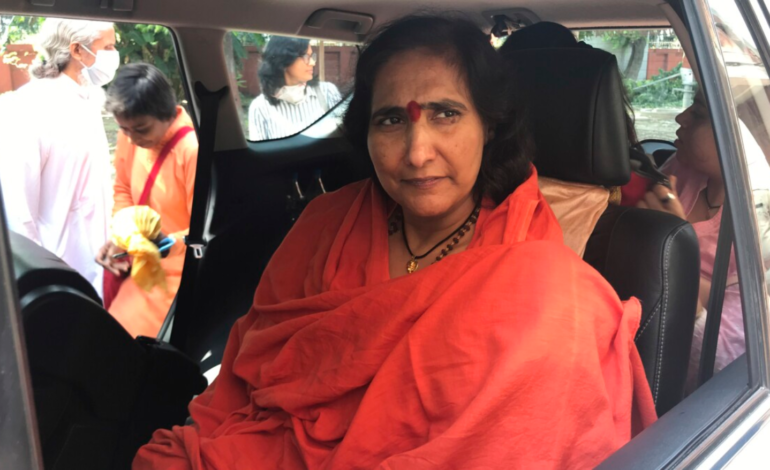
Hindu community condemns hateful attack on Sadhvi Ritambhara in Sun-Times; Hemant Patel issues detailed rebuttal
By Dr. Avi Verma | IndoUS Tribune | April 25, 2025
In a sharply worded opinion piece published on April 18, 2025, titled “I wouldn’t roll out welcome mat for this Brown woman”, Chicago Sun-Times columnist Rummana Hussain launched a scathing and deeply divisive attack on revered Hindu spiritual leader Sadhvi Ritambhara. The article, which coincides with her visit to the Hanuman Temple of Greater Chicago, has sparked outrage among thousands of Hindu Americans, particularly in Chicagoland, and is being called out for its blatant religious bias, distortion of facts, and dangerous vilification of a prominent female religious figure.
The Hindu community, particularly members of the Hanuman Mandir, has rallied to defend Sadhvi Ritambhara, with Hemant Patel, a respected Hindu leader from Chicago, issuing a detailed and powerful response directly to the Sun-Times editorial team.
A journalist’s vendetta or an editorial oversight?
Rummana Hussain’s column does not merely offer criticism; it veers into character assassination cloaked in the language of opinion journalism. From the opening line—referring to Ritambhara as a “Brown woman I find unsettling and offensive”—the article uses inflammatory language and sweeping generalizations that equate her decades-long religious activism with hate and fascism.
Hussain accuses Sadhvi Ritambhara of inciting violence in connection to the Babri Masjid demolition of 1992, despite the fact that Ritambhara and 31 others were acquitted by the Indian judiciary in 2020 after a protracted legal battle. None of this nuance or legal clarity is acknowledged in Hussain’s column, which reads more like a political screed than a fact-based editorial.
Hemant Patel responds: “What crime is reclaiming your faith?”
In his compelling rebuttal, Hemant Patel questioned the journalistic integrity of the Sun-Times for publishing unsubstantiated claims and for failing to perform even a “basic online search” before publishing such a piece.
“As a Padma Bhushan awardee, one of India’s highest civilian honors, targeting her without credible evidence is both unjust and deeply offensive to millions of Indians,” wrote Patel. “Stating hard truths about illegal occupation of temples, terrorism, and persecution driven by religious ideologies is not hate speech.”
Patel drew parallels between Hindus fighting for the Ram Mandir in Ayodhya and other religious communities reclaiming their sacred spaces, such as Christians defending the Vatican or Jews preserving the Western Wall.
“Is it a crime to reclaim one’s own sacred place?” he asked pointedly.
Selective outrage and dangerous silence
In a bold critique of the Sun-Times’ editorial priorities, Patel asked whether the outlet had even acknowledged the recent Islamic terrorist attack in Pahalgam, Kashmir, where 27–28 Hindus and Christians were killed for refusing to recite Islamic verses.
“You call out supposed hate, but ignore actual religious cleansing,” Patel said. “This hypocrisy is dangerous.”
He further reminded the Sun-Times of a 2022 article it published condemning India’s religious landscape—an article which also received criticism from the Indian American community for being “factually inaccurate and misleading.”
Community reactions and rising unity
Following the Sun-Times article, Hindu organizations and individuals have mobilized to protest what they see as biased media coverage. Platforms like Voice of Hindus and Hindutva Watch have documented community responses defending Sadhvi Ritambhara’s right to speak and to practice her faith without being vilified in Western media.
In fact, a recent petition to cancel her event at the Hanuman Temple was widely criticized as an attempt to silence Hindu voices under the guise of progressive advocacy.
The bigger picture: When journalism becomes ideological warfare
This episode is not merely about one columnist’s attack on a Hindu religious leader. It represents a growing trend of selective journalism, where figures associated with Hindu dharma are scrutinized and labeled extremists without due process, while actual religious violence against Hindus remains underreported or outright ignored.
Ironically, Hussain’s article, meant to combat bigotry, ends up perpetuating anti-Hindu hate speech by stereotyping not only Ritambhara but also her millions of followers as fascist and dangerous.
Final thoughts from the Publisher
The IndoUS Tribune stands firm in defending freedom of speech, freedom of religion, and the dignity of India’s spiritual leaders. While critical journalism is vital, it must be balanced, fact-checked, and rooted in truth—not in prejudice or personal resentment.
We echo Hemant Patel’s call: If there exists credible video evidence of hate speech from Sadhvi Ritambhara, present it. Otherwise, retract the column and issue a clarification. Journalism is not meant to fuel communal hate but to shed light on the truth.
As we reflect on this troubling development, one question remains: Is it journalism, or is it just prejudice in print?